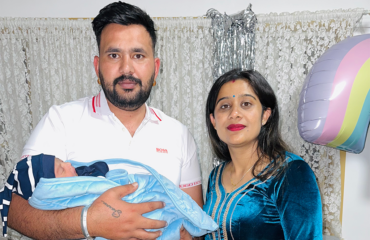It’s a Sunday night and you’re sitting in the passenger seat of a policewoman’s car.
In less than an hour she’ll be looking at your naked chest.
“Have you ever been in a police car?”
You shake your head.
“This will be a cool thing to tell people!”
Your mum doesn’t know what he did yet.
“I’m a mother,” she tells you. “Two boys.”
You nod.
When a woman or girl reports a sexual assault, she is typically asked to undergo a forensic medical examination.
This is best performed within 48 hours of the attack in order to preserve as much evidence as possible. The purpose of these examinations is primarily to observe and collect evidence that can be compiled into a report and used by prosecutors to bring a case against the accused perpetrator in a court of law.
The intersection in this moment, between an invasive procedure and a time sensitive one, is traumatic and imperative. This can lead to a second trauma for the survivor to process.
Of course it is necessary for the legal system to require evidence to support prosecution, and naturally such evidence should be collected promptly in order to maintain its integrity.
Nonetheless, women are routinely asked to make crucial decisions about whether to undergo these examinations at a time of severe distress, while also being told that unless they consent, their options for pursuing legal actions down the track are significantly diminished. It is a gut-wrenching dilemma for a survivor still reeling from her ordeal.
There may be no painless escape from this situation. Nonetheless it is appropriate – necessary – to understand these shrouded processes, to articulate the excruciating requirements our legal systems places upon women seeking justice for the crimes committed against them.
“I already told all this to the police.”
The nurse is patient with you, but the blank lines on her clipboard want filling.
“Please tell me again. Where did he hurt you?”
Dr Jo Ann Parkin is a forensic specialist who regularly performs medical examinations of survivors of sexual assault. She is energetic and passionate about her work, offering a tour of the Victorian Institute for Forensic Medicine in South Melbourne where she works, but pandemic restrictions get in the way. Instead, she speaks to me for almost two hours about the processes and flaws that exist within this area of the forensic profession over a grainy Zoom call from a mobile phone propped up in a corner of her office.
There are a number of ways a forensic examination can be completed, she explains, making clear that the patient’s autonomy is always paramount. Dr Parkin says she begins by developing rapport with a patient. She walks through what the examination would involve, and why its important if she wants to proceed with legal charges. A patient may submit to a partial examination or no examination at all.
There is no prescribed order or procedure, except that the examinations are carried out in accordance with the highest forensic standards in order to prevent contamination of the samples collected. A typical examination could include a head to toe visual inspection, where a woman’s naked body is studied closely for bruises, lacerations or other injuries she may have sustained.
“We’re looking for injuries on the body that they may not be aware of,” says Dr Parkin. “I’d say 60 per cent of the time we may well find something.”
Next, photographs might be taken of any sites of injury on the patient’s body before she is propped on a bed and her legs put in stirrups so the physician can perform an inspection of the anal-genital region. Photographs of this region are also an important component of the examination.
Swabs are taken to collect DNA evidence which might be later used in a courtroom. Her mouth, breasts, buttocks, vagina and anus are all sites that may be swabbed.
Specialists performing these examinations need to be prepared for anything.
“I’ve stuck a speculum in and there’s been a clot and then the blood flows everywhere” Dr Parkin recalls.
“We might find razor blades in a vagina that may have been self-put, there may have been sticks put in a vagina from an assailant.”
Sometimes she might spend up to three hours with a victim, not only performing a forensic examination but also providing initial care following the assault.
All heating to the room has been switched off.
You drop one layer of clothing after the other into a plastic bag held out by the policewoman.
You’re remembering how he unceremoniously removed your layers last night.
It’s August and your phone tells you it’s five degrees outside.
A common stressor for survivors presenting following a sexual assault is the requirement that they retell their story sometimes four or five times before reaching a forensic specialist.
“It’s horrific,” says Dr Parkin. She describes the exasperation of the women she meets, who are passed along to one person and then another before seeing a doctor.
“We find it so frustrating that by the time they get to us they may well have spoken to the sexual assault crisis line, they may have spoken to a uniform police officer, they may have spoken to a specialist police officer, then to a counsellor, then to us. By the time they get to us they don’t want to say anything anymore and unfortunately a lot of the time we are the one person that they should be probably giving details to.”
For most women, these examinations come at the end of what has already been a disastrously long day or, more often, night. They’re tired, scared, distressed, confused and highly traumatised, and yet expected to make informed decisions about what else they’re willing to put their body through.
The policewoman brings a camera from the station about the size of her head.
“Look neutral.”
It feels weird to frown at lens aimed at your face.
“Just like posing for a drivers license.”
You’re wondering what a stranger in jury would find sympathetic.
The reality of forensic medical examinations is bleaker still for women presenting in regional communities. Outside of metropolitan areas, Dr Parkin tells me that funding doesn’t really exist for forensic specialists. Instead, GPs, nurses and hospital staff are forced to pick up the slack, often working outside the regular hours of their full time job to collect and compile the reports that will sometimes decide whether a woman’s complaint is heard in court.
“They’ll finish their work at 10.30pm and then get a sexual assault call, and then if they’re not starting at six or seven the next morning they’ll try and fit in a sexual assault examination.”
Survivors of sexual assault outside of metropolitan areas must undergo these examinations in hospital emergency rooms that are subject to all the usual pressures of long wait times and staff shortages and getting bumped down the priority list by more urgent cases. Though the Australian Health Practitioner Regulation Agency (AHPRA) has set a standard that states that these examinations must be performed by forensic specialists, this simply isn’t an option for those living beyond the cities.
You’re on your back.
The nurse is on the phone to someone in a different city who’s reading instructions to her.
“This is my first time” she tells you.
“Mine too.”
From behind her surgical mask she attempts a smile.
Dr Parkin explains that this is not necessarily a failing of our medical system. In Victoria, forensic specialists like her work under the purview of the Department of Justice, not the health department. Medical professionals describe a disconnect between these two realms.
She speaks plainly of her frustrations that survivor wellbeing is often secondary to the need to maintain the forensic integrity of the evidence. At that point in their trauma, survivors of sexual violence require specialist care above all other things, from both a medical and mental health perspective. And yet the justice-minded approach to medical treatment means the survivor is dealt with like a walking and breathing crime scene, rather than the victim of a crime.
“Just take the word ‘sexual’ away!” she pleads.
“When someone is assaulted, they’ve been just assaulted, not sexually assaulted … everyone jumps in and fixes that problem for that individual … if they’ve broken their arm, if they’ve got bleeding from their back passage or whatever, they just treat it. But as soon as you put the word sexual in front of it it’s a stand-off approach.”
The instruments she uses are cold against your skin.
His hands had been hot.
“Do you want me to do a pap smear while I’m down here?”
You tell her no.
Dr Parkin makes clear the distinction between medical care and a forensic examination, and the importance of providing a survivor with both.
Medical care might involve identifying the symptoms of non-fatal strangulation – which, I’m told, is presently a favoured “modus operandi” of assailants – or sewing up a vagina, or simply knowing when a survivor has reached her limit. The purpose of the forensic examination is to collect evidence of a crime. While the two processes can occur concurrently, and often do, they require distinct skills, which is why Dr Parkin advocates for “centres of excellence” that can provide all relevant services to a survivor within a single facility.
She reels off her wish list for an ideal facility. A shared space run alongside a hospital’s emergency room with a full time staff of specialists in gynaecology, forensics, social work, trauma, law and where police can be called if necessary. The centres would exist inside both metropolitan and regional hospitals and be properly funded to minimise wait times and maximise opportunities for providing care for survivors.
This is what the medical profession needs in order to adequately support victims of sexual violence and yet at present, no such centres exist in Australia.
The nurse drapes a hospital gown over your shoulders and begins to fasten it,
You roll your eyes at her sudden interest in modesty and waddle to the bathroom
The door doesn’t lock properly so the policewoman, armed, stands guard.
The question that keeps nagging, listening to Dr Parkin and other specialists in this hidden realm, is why it is still so difficult for women to hold violent men accountable. Surely we should be encouraging women to come forward with their complaints? We should want women to be able to access our justice system with the fewest possible roadblocks?
Violent men who are not held to account will always continue to be violent. It is in everyone’s interests to expose perpetrators of violence.
It is true that women are not explicitly coerced into a forensic examination. No one makes it a condition of their reporting, and they can refuse to talk to doctors or police at any point.
However, it is made punishingly clear in the immediate aftermath of an assault, to women still shocked, traumatised, hurting, likely bleeding, that it is a condition they are required to meet if they ever want to pursue legal action against their attacker.
As a forensic examination is a requirement for women to access justice for the crimes committed against them, it is not in a survivor’s interests to refuse one.
And if such examinations are essential for justice, then such a justice system needs to provide every possible concession and comfort for survivors. At present, it does not.
“The system that we have is a broken system and it’s one that I don’t think does the right amount of justice for the victim-survivor in terms of providing the easiest flow of treatment and access to care and, I would like it changed” says Dr Parkin.
The policewoman and the nurse smuggle you out a different way to how you came in.
He’s on his way in for his swabs, they explain.
He’s coming through the main entrance a few minutes behind you.
For the rest of your life he’ll always be a few minutes behind you.




